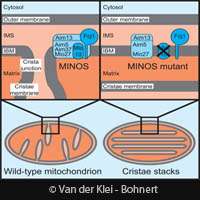New mitochondria mechanism identified

A team of researchers led by the University of Freiburg in Germany has identified a novel mechanism that plays a key role in the architecture and functioning of mitochondria - the power plants of the cell, giving cells the energy they need to move and divide and generate secretory products. The results are published in the journal Developmental Cell.
Chemical reactions generated at the mitochondria's inner membranes help these power centres convert food into energy, giving cells the boost they need for metabolism and growth.
Headed by Freiburg's Dr Martin van der Laan and Professor Bettina Warscheid, the study brought together experts from Germany, the Netherlands, Poland and Switzerland. They say the inner mitochondrial membrane has a characteristic architecture that is necessary for its function as a converter of energy. When the mitochondria structure contains errors, people can be diagnosed with serious illnesses, including disorders that impact their nerves and muscles.
The inner mitochondrial membrane creates tubular invaginations, what experts call cristae. An outer mitochondrial membrane envelops the power plant producers. What researchers knew is that this structure is the same in all organisms, whether it is in humans or single-cell life forms; but questions existed about the microstructure's makeup. This study answered these questions.
The researchers identified a huge molecular machine made up of six different membrane proteins required for attaching the cristae to the envelope of the mitochondria in the unicellular model organism baker's yeast. The data show that the defects in the protein complex trigger the detachment of the cristae, which in turn results in significant growth disturbances in the cell.
Collaborating with Professor Agnieszka Chacinska from the Warsaw, Poland-based International Institute for Molecular and Cell Biology, the scientists successfully showed how important a role this protein machinery plays for both the inner architecture of the cellular power plants and the formation of molecular contact points between the two mitochondrial membranes. The bridges of the membranes help give the transport of new proteins generated outside into the mitochondria a big boost.
Thanks to this study and the results of the architecture of mitochondria, researchers can piece together a puzzle impacting cellular biology. In particular, it helps us better understand the structure and performance of cellular power plants. The results could also lead to more knowledge about the mechanisms of disorders that involve modifications in the structure of mitochondria.
More information: Van der Laan, M., et al. (2011) 'Dual role of mitofilin in mitochondrial membrane organization and protein biogenesis', Developmental Cell, published 22 September. DOI: 10.1016/j.devcel.2011.08.026
Provided by CORDIS
















